Tropical Cyclone Temperature Profiles and Cloud Macro-/Micro-Physical Properties Based on AIRS Data
Abstract
:1. Introduction
2. Experiments
2.1. Data
2.1.1. AIRS Data
2.1.2. TC Best Track Data
2.2. Methods
2.2.1. Data Matching
2.2.2. Warm-Core Calculation
2.2.3. Synthetic Method
2.2.4. Lattice Processing
3. Results and Discussion
3.1. Relationship Between Warm-Core Strength and TC Intensity
3.2. Warm Core Height Distribution
3.3. Analysis of Warm Core Structure with Different TC Intensities
3.4. Analyses of Macro-/Micro- Physical Properties of TC Cloud Systems by Intensity
4. Conclusions
- (1)
- There was a positive correlation between TC intensity and warm core strength (correlation coefficient is 0.8556). Correlation coefficients varied by intensity class, with the highest value (0.496) for TY. The linear fitting results also showed that TC intensity increased with increasing warm core strength. However, warm core strength and TC intensity were not correlated for TD because the convection around the TC center was not strong enough, weakening the nearby sinking warming and latent heat heating effects; the temperature anomalies between the TC center and the surrounding area were slightly different. In addition, inversion errors within the AIRS temperature data might also have erased the weak warm cores.
- (2)
- Vertical distributions of warm core height varied with TC intensity and warm core height slightly increased as TC intensity increased. For TD and TS, warm core heights were mainly distributed from 300 to 500 hPa, the range of STS was from 300 to 450 hPa, and that of TY and Super TY from 300 to 350 hPa. The vertical distribution of temperature structure showed that the warm core strength increased gradually from 1 K for TD to >15 K for Super TY. The vertical areas affected by warm core strength grew with increasing TC intensity.
- (3)
- The tops of TC cloud systems mainly consisted of ice clouds, which accounted for more than 90% of all samples regardless of the TC intensity. As TC intensity increased, cloud fraction and effective diameter of ice particles near the TC center gradually increased, while cloud-top pressure and temperature gradually decreased. With the increase in TC intensity, the vertical convection was stronger and the vertical heat transport by clouds was more significant, contributing to a warmer warm core.
Author Contributions
Funding
Acknowledgments
Conflicts of Interest
References
- Liu, Q.; Weng, F. Detecting the warm core of a hurricane from the Special Sensor Microwave Imager Sounder. Geophys. Res. Lett. 2006, 33, L06817. [Google Scholar] [CrossRef]
- Zhang, H.; Chou, J.; Qiu, C. Assimilation analysis of Rammasun typhoon structure over Northwest Pacific using satellite data. Chin. Sci. Bull. 2004, 49, 389–395. [Google Scholar] [CrossRef]
- Wei, Y.; Xu, J.; Zhou, X. Application of NOAA-AMSU microwave soundings to Typhoon Dujuan. J. Trop. Meteorol. 2005, 21, 359–367. (In Chinese) [Google Scholar]
- Zhu, X.; Yu, H.; Yin, Q.; Mao, Z. Satellite-based analysis of concentric eyewall replacement cycles with super Typhoon Muifa (1109). J. Trop. Meteorol. 2014, 30, 34–44. (In Chinese) [Google Scholar]
- Ritchie, E.A.; Wood, K.M.; Rodríguez-Herrera, O.G.; Piñeros, M.F.; Tyo, J.S. Satellite-Derived Tropical Cyclone Intensity in the North Pacific Ocean Using the Deviation-Angle Variance Technique. Wea. Forecast. 2014, 29, 505–516. [Google Scholar] [CrossRef] [Green Version]
- Wang, X.; Ren, Y.; Li, X. The warm-core structure of Super Typhoon Rammasun derived by FY-3C microwave temperature sounder measurements. Atmos. Sci. Let. 2016, 17, 432–436. [Google Scholar] [CrossRef] [Green Version]
- Yan, L.; Zhou, Y.; Liu, X. Dynamic and thermodynamic structure analysis of Typhoon Matmo (1410) and associated moisture characteristics before and after its landfall. Chin. J. Atmos. Sci. 2017, 41, 289–301. (In Chinese) [Google Scholar]
- Yu, Z.; Wang, Y.; Xu, H.; Davidson, N.; Chen, Y.; Chen, Y.; Yu, H. On the Relationship between Intensity and Rainfall Distribution in Tropical Cyclones Making Landfall over China. J. Appl. Meteorol. Clim. 2017, 56, 2883–2901. [Google Scholar] [CrossRef]
- Zhang, W.; Rutledge, S.A.; Xu, W.; Xu, W.; Zhang, Y. Inner-core lightning outbreaks and convective evolution in Super Typhoon Haiyan (2013). Atmos. Res. 2019, 219, 123–139. [Google Scholar] [CrossRef]
- Chane Ming, F.; Jolivet, S.; Liou, Y.-A.; Jégou, F.; Mekies, D.; Hong, J.-S. Elliptical structures of gravity waves produced by Typhoon Soudelor in 2015 near Taiwan. Atmosphere 2019, 10, 260. [Google Scholar] [CrossRef] [Green Version]
- Chen, B.-F.; Chen, B.; Lin, H.-T.; Elsberry, R.L. Estimating Tropical Cyclone Intensity by Satellite Imagery Utilizing Convolutional Neural Networks. Weather Forecast. 2019, 34, 447–465. [Google Scholar] [CrossRef]
- Jiang, H.; Tao, C.; Pei, Y. Estimation of Tropical Cyclone Intensity in the North Atlantic and Northeastern Pacific Basins Using TRMM Satellite Passive Microwave Observations. J. Appl. Meteorol. Clim. 2019, 58, 185–197. [Google Scholar] [CrossRef] [Green Version]
- Wang, J.; Zhang, L.; Guan, J.; Zhang, M. Comparison of assimilating all-sky and clear-sky satellite radiance for Typhoon Chan-Hom and Nangka forecasts. Atmosphere 2020, 11, 599. [Google Scholar] [CrossRef]
- Velden, C.S.; Herndon, D. A Consensus Approach for Estimating Tropical Cyclone Intensity from Meteorological Satellites: SATCON. Weather Forecast. 2020, 35, 1645–1662. [Google Scholar] [CrossRef]
- Chen, L.; Xu, X.; Luo, Z.; Wang, J. Introduction to Tropical Cyclone Dynamics; China Meteorological Press: Beijing, China, 2002; p. 317. (In Chinese) [Google Scholar]
- Brand, S. Interaction of binary tropical cyclones of the western North Pacific Ocean. J. Appl. Meterol. 1970, 09, 433–441. [Google Scholar] [CrossRef]
- Stern, D.P.; Zhang, F. The warm-core structure of Hurricane Earl (2010). J. Atmos. Sci. 2016, 73, 3305–3328. [Google Scholar] [CrossRef]
- Kidder, S.Q.; Goldberg, M.D.; Zehr, R.M.; DeMaria, M.; Purdom, J.F.W.; Velden, C.S.; Grody, N.C.; Kusselson, S.J. Tropical Cyclone Analysis using AMSU Data. In Proceedings of the AMS 10th Conference on Satellite Meteorology and Oceanography, Long Beach, CA, USA, 14–18 January 2020; pp. 185–188. [Google Scholar]
- Kidder, S.Q.; Goldberg, M.D.; Zehr, R.M.; DeMaria, M.; Purdom, J.F.W.; Velden, C.S.; Grody, N.C.; Kusselson, S.J. Satellite analysis of tropical cyclones using the Advanced Microwave Sounding Unit (AMSU). Bull. Amer. Meteorol. Soc. 2000, 81, 1241–1259. [Google Scholar] [CrossRef] [Green Version]
- Liu, Z.; Li, W.; Han, Z.; Yao, Z.; Zhang, F.; Zhu, Y. Estimating the intensity of tropical cyclone in Western North Pacific basin with AMSU-A brightness temperature. Chin. J. Geophys. -Chin. Ed. 2008, 51, 51–57. [Google Scholar] [CrossRef]
- Zhong, Y.; Xu, M.; Wang, Y. Thermal structure characteristics of the extratropical transition of Tropical Cyclone Chaba (0417). J. Appl. Meteorol. Sci. 2008, 19, 588–594. [Google Scholar]
- Wang, Y.; Zhang, H.; Wang, B.; Han, Y.; Cheng, X. Reconstruct the Mesoscale Information of Typhoon with BDA Method Combined with AMSU-A Data Assimilation Method. Adv. Meteorol. 2010, 2010, 346516. [Google Scholar] [CrossRef]
- Tian, X.; Zou, X. Capturing size and intensity changes of hurricanes Irma and Maria (2017) from Polar-Orbiting Satellite Microwave Radiometers. J. Atmos. Sci. 2018, 75, 2509–2522. [Google Scholar] [CrossRef]
- Zhang, Z.; Wang, Y.; Zhang, W.; Xu, J. Coastal ocean response and its feedback to typhoon Hato (2017) over the South China Sea: A Numerical Study. J. Geophys. Res. -Atmos. 2019, 124, 13731–13749. [Google Scholar] [CrossRef]
- Tang, X.; Ping, F.; Yang, S.; Li, M.; Peng, J. On the rapid intensification for Typhoon Meranti (2016): Convection, warm core, and heating budget. Front. Earth Sci. 2019, 13, 791–807. [Google Scholar] [CrossRef]
- Shin, J.H. Vortex spinup process in the extratropical transition of Hurricane Sandy (2012). J. Atmos. Sci. 2019, 76, 3589–3610. [Google Scholar] [CrossRef]
- Deng, L.; Gao, W.; Duan, Y.; Wang, Y. Microphysical properties of rainwater in Typhoon Usagi (2013): A numerical modeling study. Adv. Atmos. Sci. 2019, 36, 510–526. [Google Scholar] [CrossRef]
- Oyama, R.; Wada, A. The relationship between convective bursts and warm-Core intensification in a nonhydrostatic simulation of Typhoon Lionrock (2016). Mon. Weather Rev. 2019, 147, 1557–1579. [Google Scholar] [CrossRef]
- Stern, D.P.; Nolan, D.S. On the Height of the Warm Core in Tropical Cyclones. J. Atmos. Sci. 2012, 69, 1657–1680. [Google Scholar] [CrossRef]
- Durden, S.L. Observed Tropical Cyclone Eye Thermal Anomaly Profiles Extending above 300hPa. Mon. Weather Rev. 2013, 141, 4256–4268. [Google Scholar] [CrossRef]
- Zhang, D.; Chen, H. Importance of the upper-level warm core in the rapid intensification of a tropical cyclone. Geophys. Res. Lett. 2012, 39, L02806. [Google Scholar] [CrossRef] [Green Version]
- Fei, J. Stability of off-stage wind disturbance under approximate actual wind field conditions. Acta Trop. Meteorol. Sin. 1996, 12, 18–24. [Google Scholar]
- Velden, C.S.; Smith, W.L. Monitoring Tropical Cyclone Evolution with NOAA Satellite Microwave Observations. J. Clim. Appl. Meteorol. 1983, 22, 714–724. [Google Scholar] [CrossRef] [Green Version]
- Wang, X.; Jiang, H. A 13-year global climatology of tropical cyclone warm-core structures from AIRS data. Mon. Weather Rev. 2019, 147, 773–790. [Google Scholar] [CrossRef]
- Gao, S.; Chen, B.; Li, T.; Wu, N.; Deng, W. AIRS-observed warm core structures of tropical cyclones over the western North Pacific. Dyn. Atmos. Ocean. 2017, 77, 100–106. [Google Scholar] [CrossRef]
- Zhu, T.; Weng, F. Hurricane Sandy warm-core structure observed from advanced technology microwave sounder. Geophys. Res. Lett. 2013, 40, 3325–3330. [Google Scholar] [CrossRef]
- Knight, D.B.; Davis, R.E. Contribution of tropical cyclones to extreme rainfall events in the southeastern United States. J. Geophys. Res. 2009, 114, D23102. [Google Scholar] [CrossRef] [Green Version]
- Jiang, H.; Zipser, E.J. Contribution of Tropical Cyclones to the Global Precipitation from Eight Seasons of TRMM Data: Regional, Seasonal, and Interannual Variations. J. Clim. 2010, 23, 1526–1543. [Google Scholar] [CrossRef]
- Bagtasa, G. Contribution of Tropical Cyclones to Rainfall in the Philippines. J. Clim. 2017, 30, 3621–3633. [Google Scholar] [CrossRef]
- Mei, W.; Primeau, F.; McWilliams, J.C.; Pasquero, C. Sea surface height evidence for long-term warming effects of tropical cyclones on the ocean. Proc. Natl. Acad. Sci. USA 2013, 110, 15207–15210. [Google Scholar] [CrossRef] [Green Version]
- Fu, Y.; Xian, T.; Lu, D.; Liu, G.; Heng, Z.; Sun, L.; Liu, Q.; Wang, Y. Ozone vertical variations during a typhoon derived from the OMI observations and reanalysis data. Chin. Sci. Bull. 2013, 58, 3890–3894. [Google Scholar] [CrossRef] [Green Version]
- Wu, D.L.; Austin, R.T.; Deng, M.; Durden, S.L.; Heymsfield, A.J.; Jiang, J.H.; Lambert, A.; Li, J.-L.; Livesey, N.J.; McFarquhar, G.M.; et al. Comparisons of global cloud ice from MLS, CloudSat, and correlative data sets. J. Geophys. Res. 2009, 114, D00A24. [Google Scholar] [CrossRef] [Green Version]
- Black, R.A.; Hallett, J. Observations of the distribution of ice in hurricanes. J. Atmos. Sci. 1986, 43, 802–822. [Google Scholar] [CrossRef] [Green Version]
- Black, R.A.; Hallett, J. Electrification of the hurricane. J. Atmos. Sci. 1999, 56, 2004–2028. [Google Scholar] [CrossRef]
- Zhao, S.; Zhou, Y. Using various satellites to study typhoons Ewiniar macro and micro physical characteristics. Plateau Meteorol. 2010, 29, 1254–1260. (In Chinese) [Google Scholar]
- Mitrescu, C.; Miller, S.; Hawkins, J. Near-Real-Times applications of CloudSat data. J. Appl. Phys. 2008, 47, 1982–1994. [Google Scholar] [CrossRef]
- Zhou, Y.; Han, Y.; Wu, Y.; Wang, T.; Tang, X.; Wang, Y. Optical properties and spatial variation of tropical cyclone cloud systems from TRMM and MODIS in the East Asia region: 2010–2014. J. Geophys. Res. Atmos. 2018, 123, 9542–9558. [Google Scholar] [CrossRef]
- Bu, Y.P.; Fovell, R.G.; Corbosiero, K.L. Influence of Cloud–Radiative Forcing on Tropical Cyclone Structure. J. Atmos. Sci. 2014, 71, 1644–1662. [Google Scholar] [CrossRef] [Green Version]
- Fovell, R.G.; Bu, Y.P.; Corbosiero, K.L.; Tung, W.; Cao, Y.; Kuo, H.; Hsu, L.; Su, H. Influence of Cloud Microphysics and Radiation on Tropical Cyclone Structure and Motion. Meteorol. Monogr. 2016, 56, 11.1–11.27. [Google Scholar] [CrossRef]
- Kieu, C.; Tallapragada, V.; Zhang, D.; Almon, Z. On the development of double warm-core structures in intense tropical cyclones. J. Atmos. Sci. 2016, 73, 4487–4506. [Google Scholar] [CrossRef]
- Tobin, D.C.; Revercomb, H.E.; Knuteson, R.O.; Lesht, B.M.; Strow, L.L.; Hannon, S.E.; Feltz, W.F.; Moy, L.A.; Fetzer, E.J.; Cress, T.S. Atmospheric Radiation Measurement site atmospheric state best estimates for Atmospheric Infrared Sounder temperature and water vapor retrieval validation. J. Geophys. Res. 2006, 111, D09S14. [Google Scholar] [CrossRef] [Green Version]
- Ying, M.; Zhang, W.; Yu, H.; Lu, X.; Feng, J.; Fan, Y.; Zhu, Y.; Chen, D. An overview of the China Meteorological Administration tropical cyclone database. J. Atmos. Ocean. Technol. 2014, 31, 287–301. [Google Scholar] [CrossRef] [Green Version]
- Li, Y. A Study on the Sustaining Mechanism of Landfalling Tropical Cyclones; Chinese Academy of Meteorological Sciences: Beijing, China, 2004; pp. 34–35. (In Chinese) [Google Scholar]
- Zhao, L. Application of NOAA/AMSU Data in the Study of Typhoon in the Western Pacific. Master’s Thesis, Ocean University of China, Qingdao, China, 2009. (In Chinese). [Google Scholar]
- Niu, X. Tropical Cyclone Dynamics; China Meteorological Press: Beijing, China, 1992; p. 3. [Google Scholar]
- Li, Y.; Luo, Z. A case study on the formation of warm core structure of typhoon in the South China Sea. China Sci. Technol. Inf. 2008, 17, 29–32. (In Chinese) [Google Scholar]
- Zhang, Z. Application of NOAA/AMSU Temperature Data in the Study of Typhoon Structure and Path. Master’s Thesis, Ocean University of China, Qingdao, China, 2012. (In Chinese). [Google Scholar]
- Chen, Y.; Huang, J.; Wang, T.; Jin, H.; Ge, J. The temporal and spatial distribution of different types of clouds and their relationship with precipitation in Northwest China. J. Appl. Meteorol. Sci. 2005, 16, 718–726. (In Chinese) [Google Scholar]
- Yan, Y.; Tan, J.; Cui, L.; Yu, W.; Hu, Y. Asymmetry of Cloud Vertical Structures and Associated Radiative Effects in Typhoon over the Northwest Pacific Based on CloudSat Tropical Cyclone Dataset. Asia-Pac. J. Atmos. Sci. 2020, 56, 515–532. [Google Scholar] [CrossRef]
- Gao, Y.; Fang, X. Analyses on vertical structure and microphysical features of typhoon cloud in the Western Pacific based on CloudSat satellite data. Meteorol. Mon. 2018, 44, 597–611. (In Chinese) [Google Scholar]
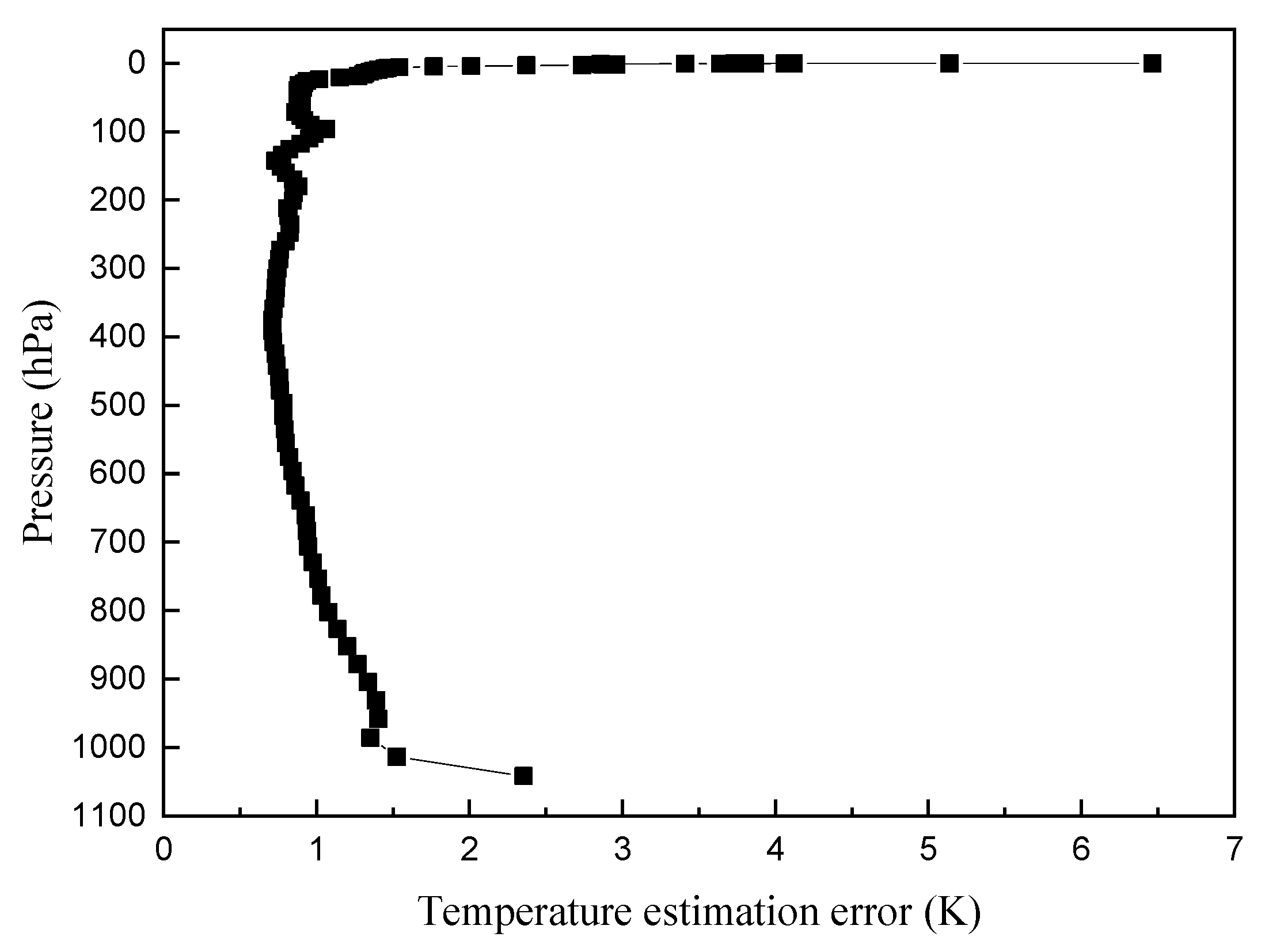
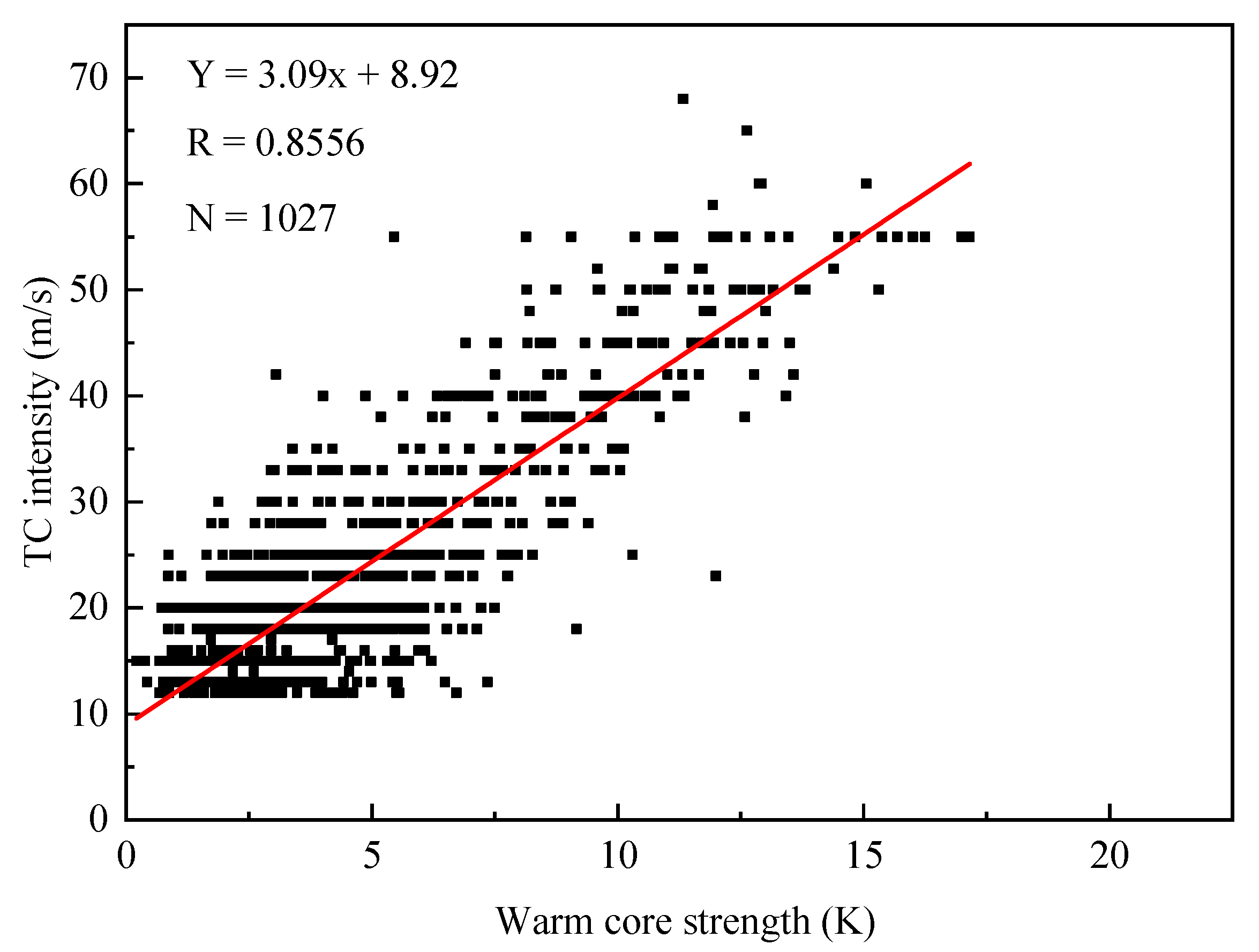
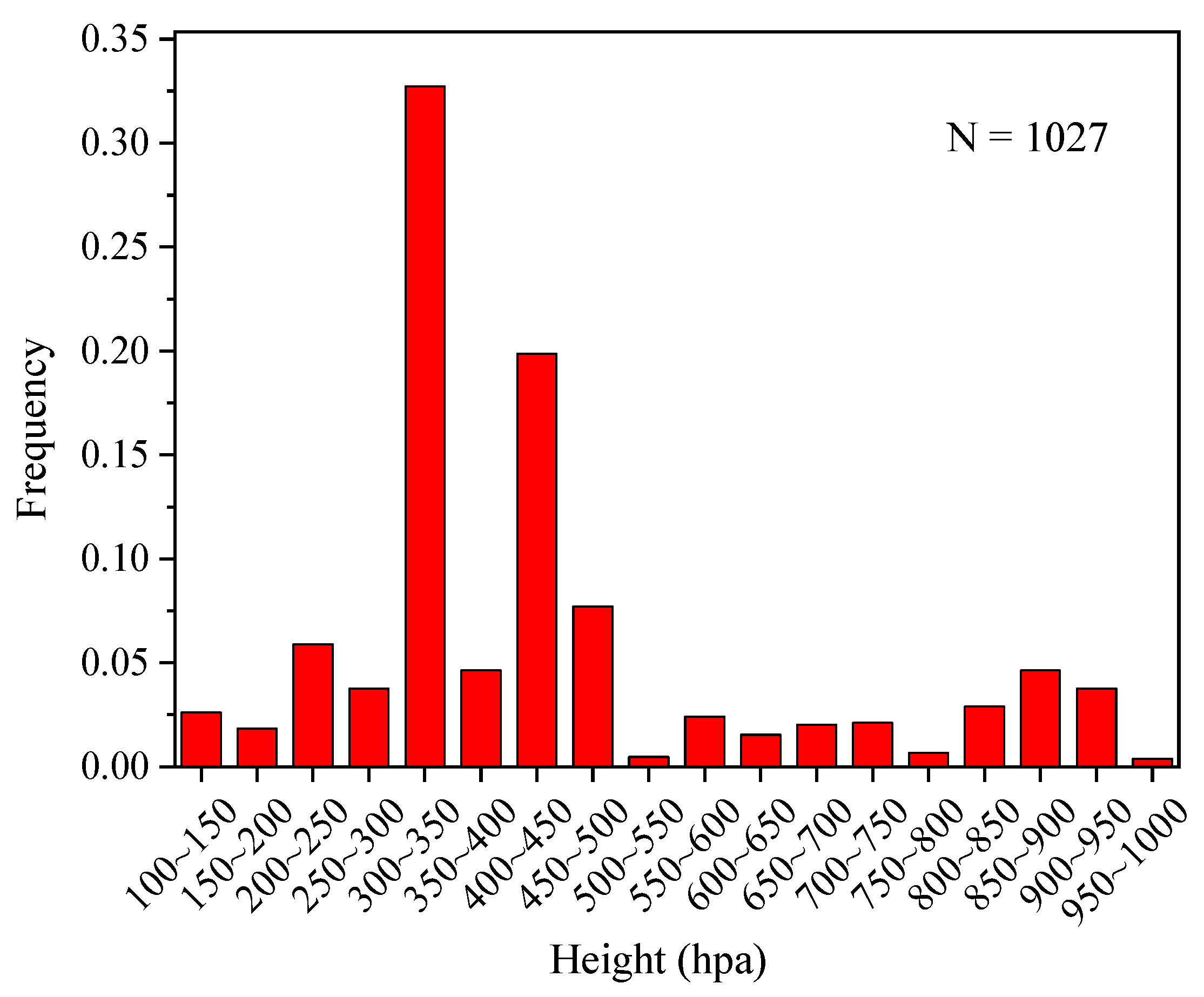
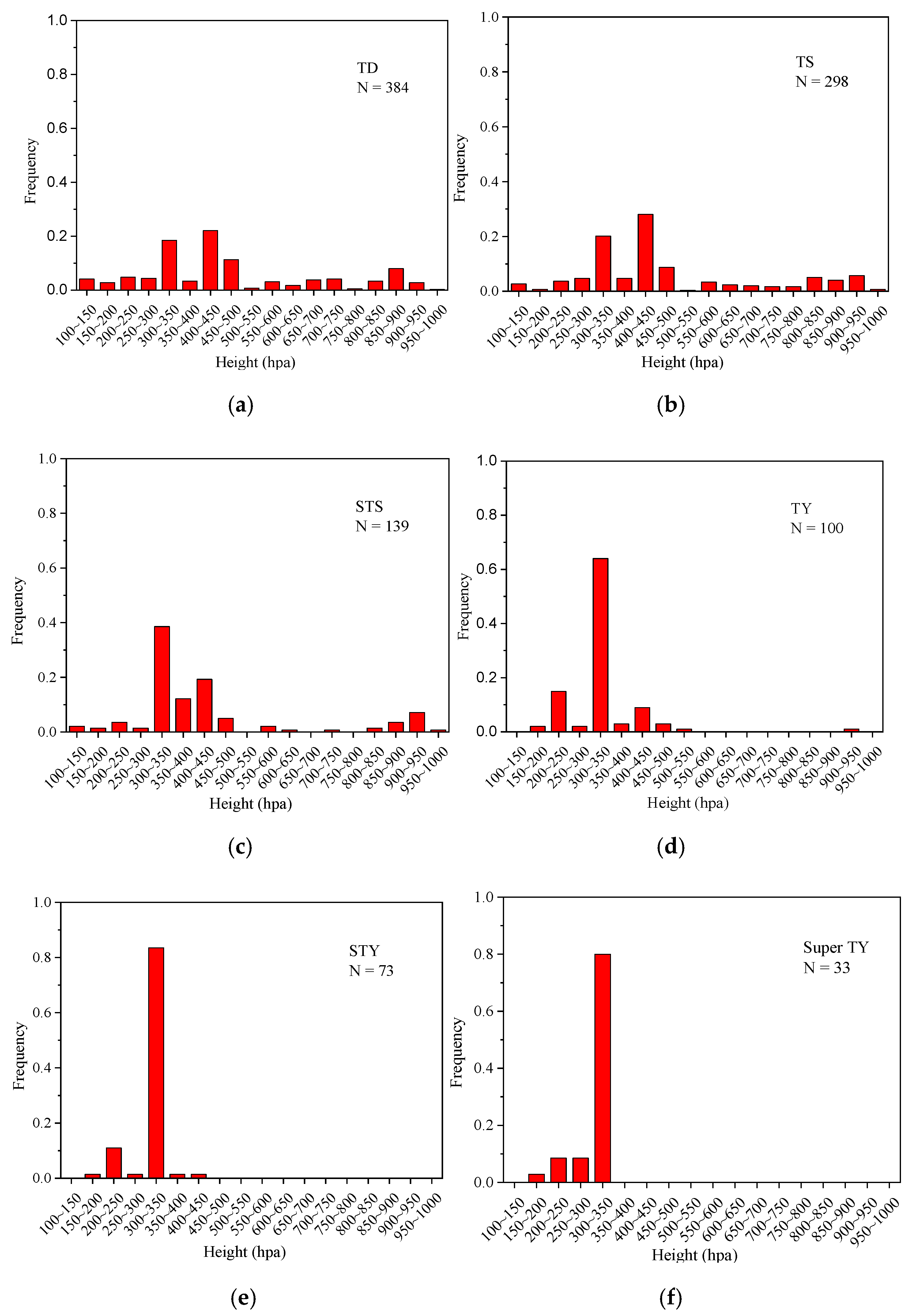
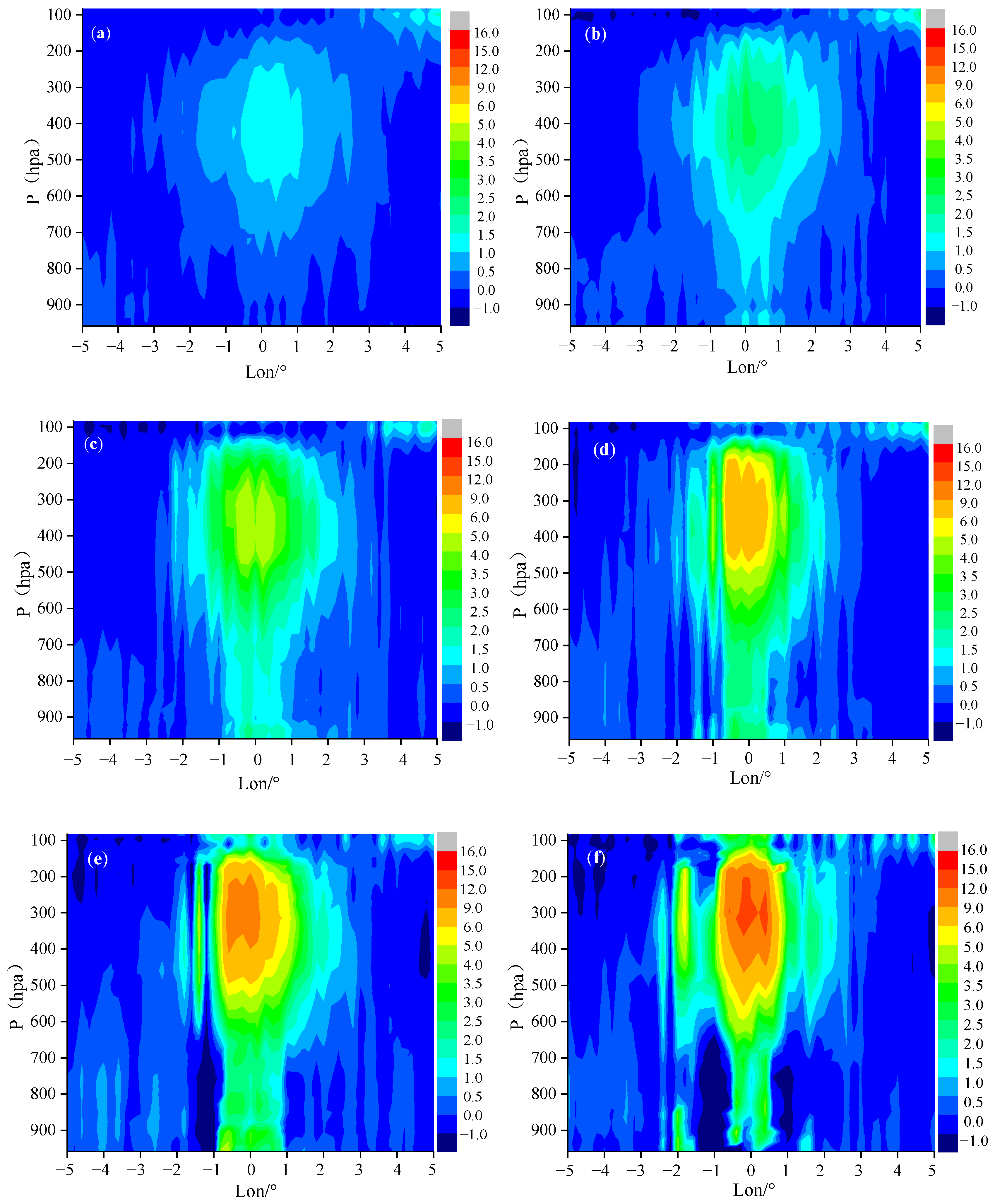
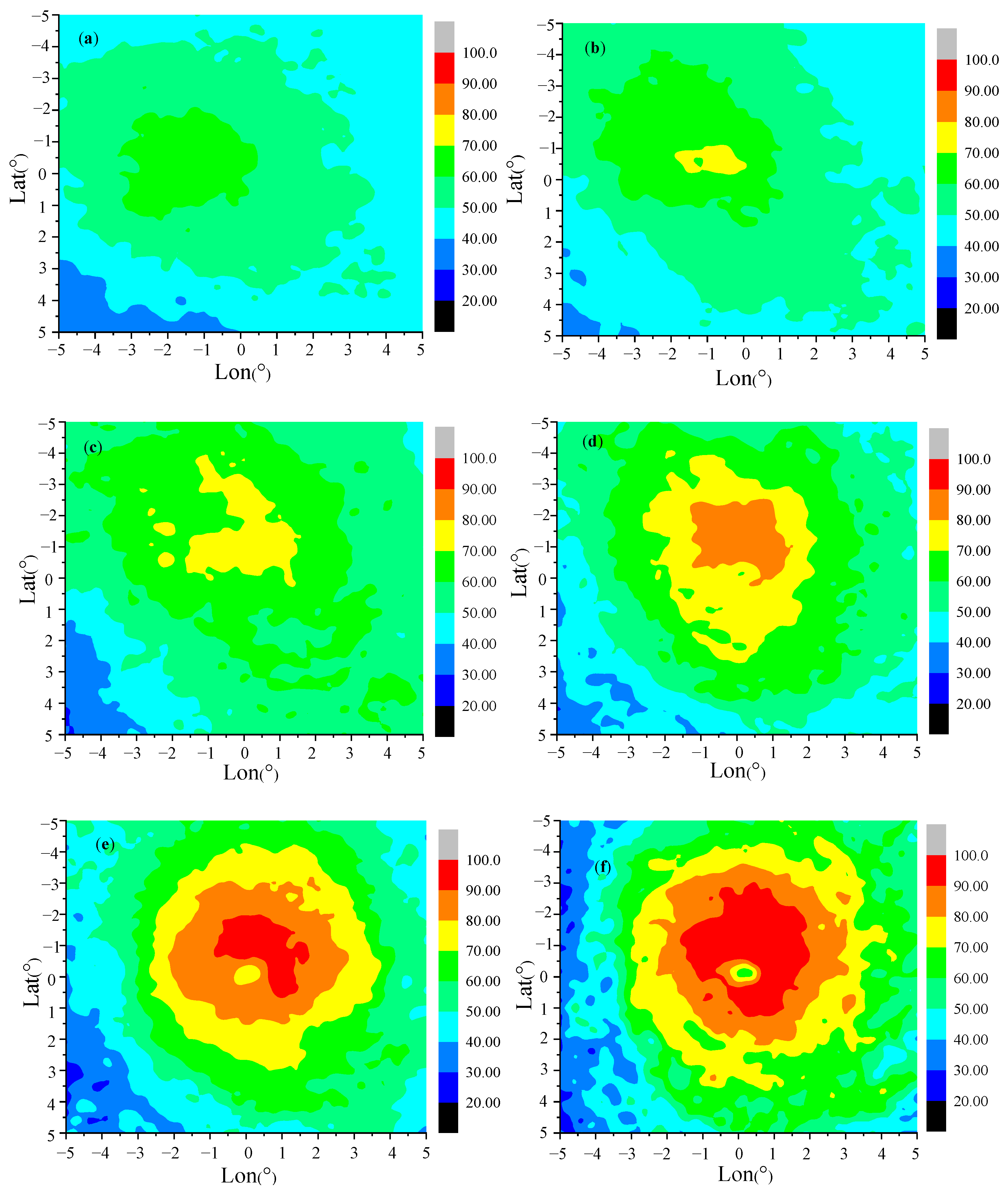
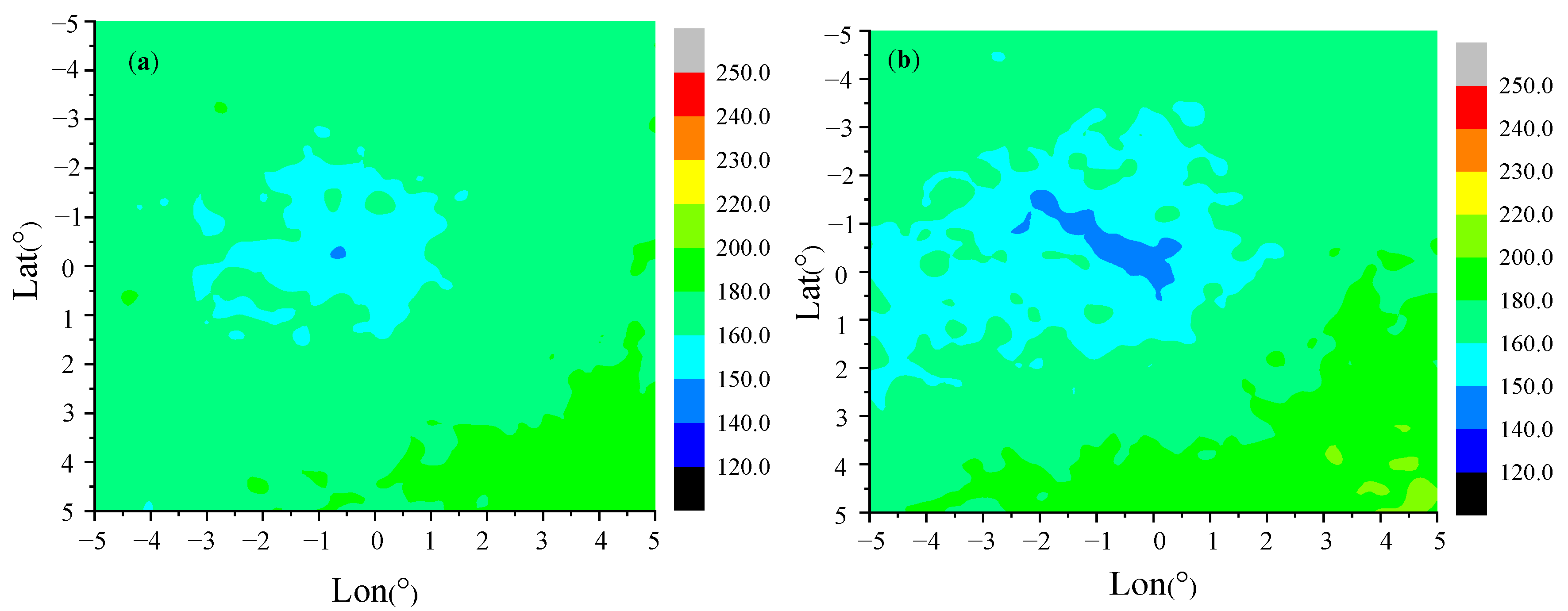
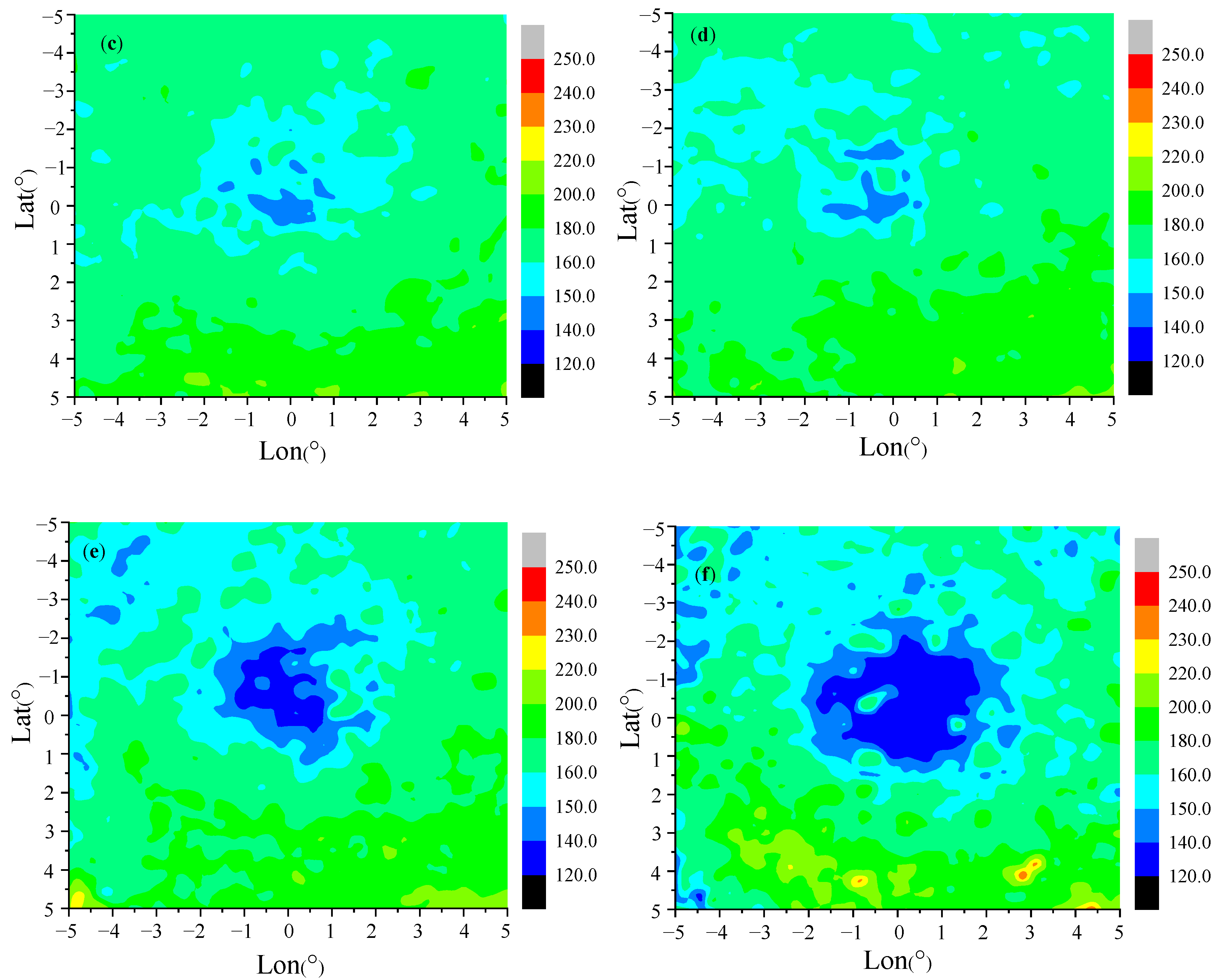
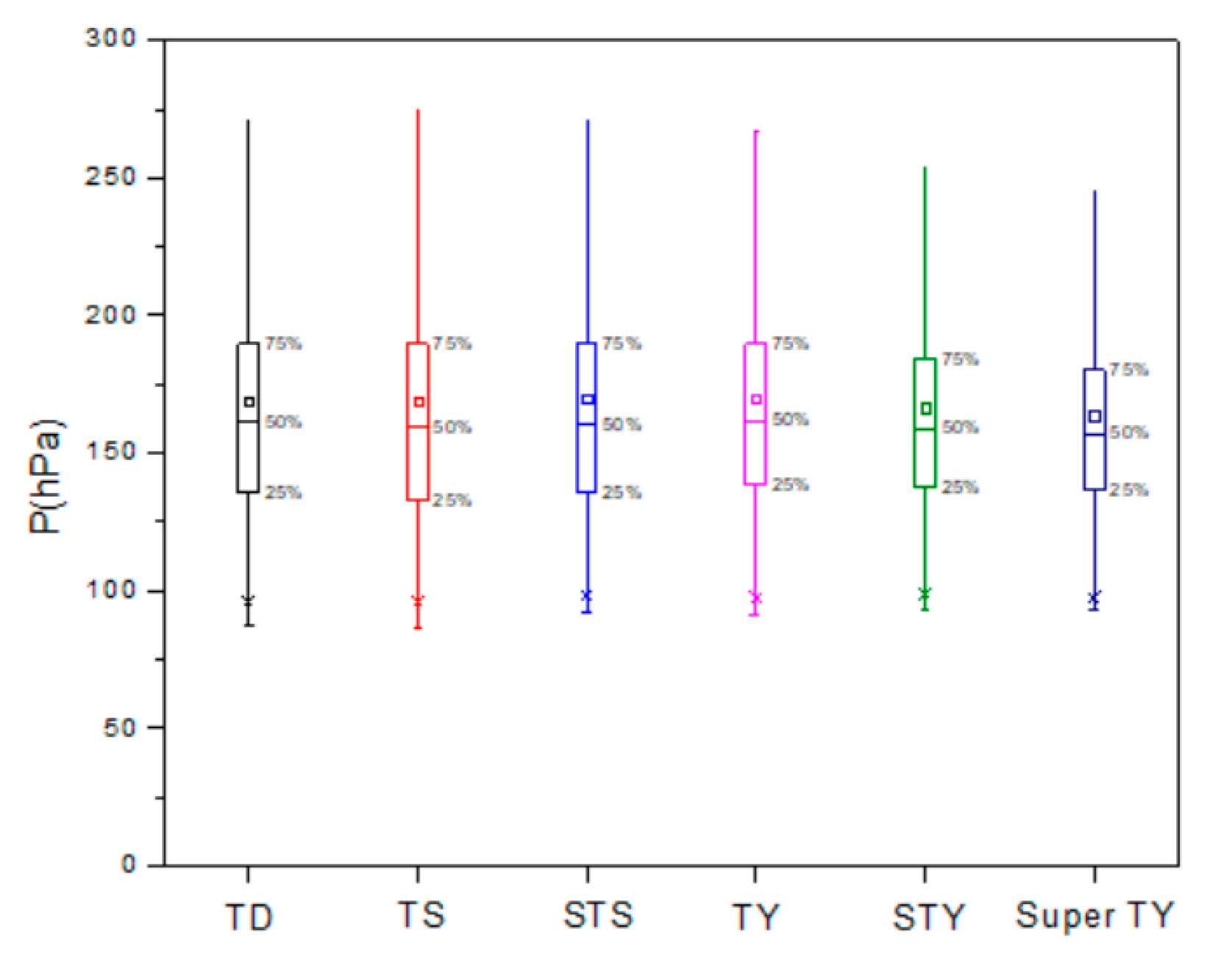
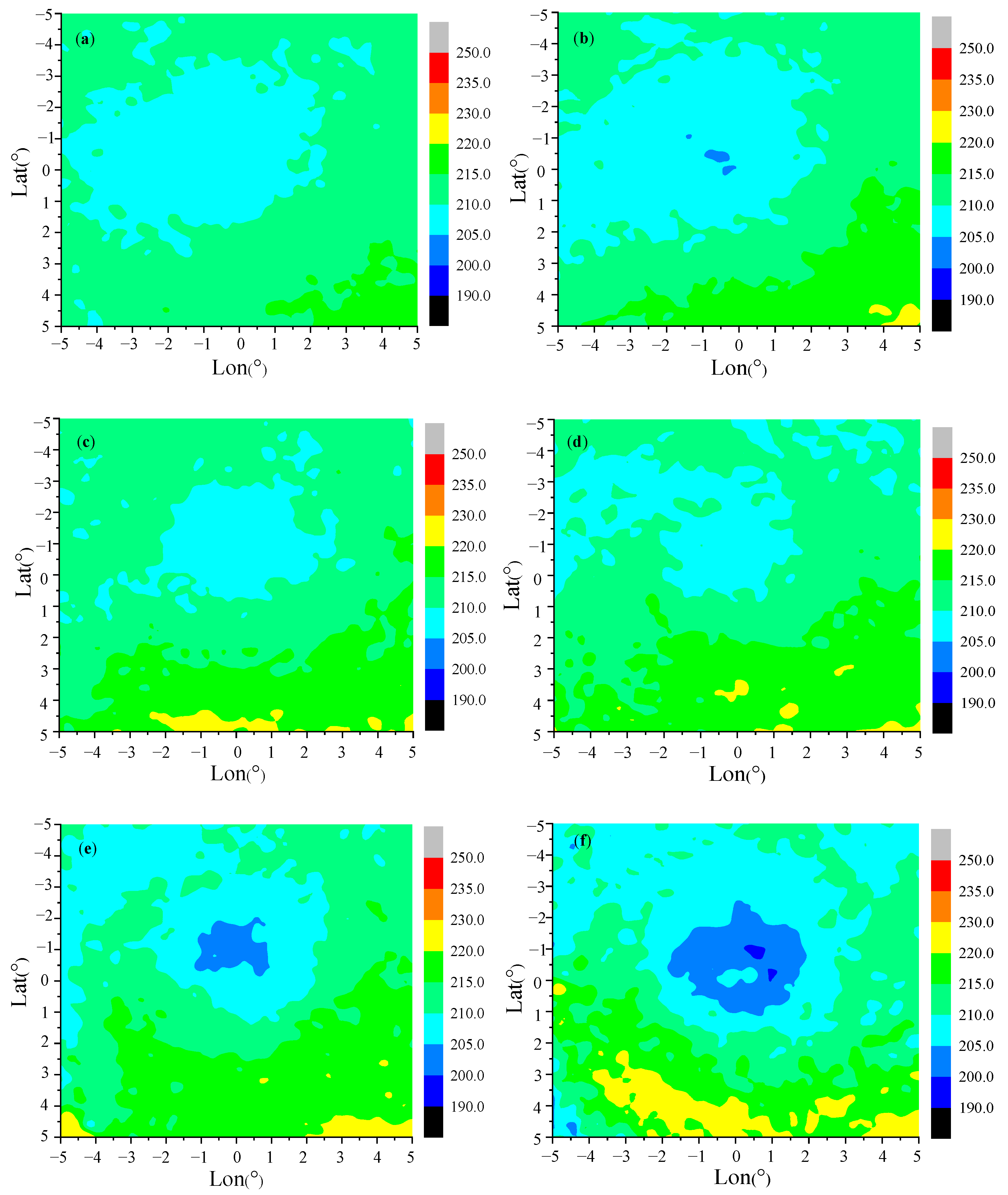
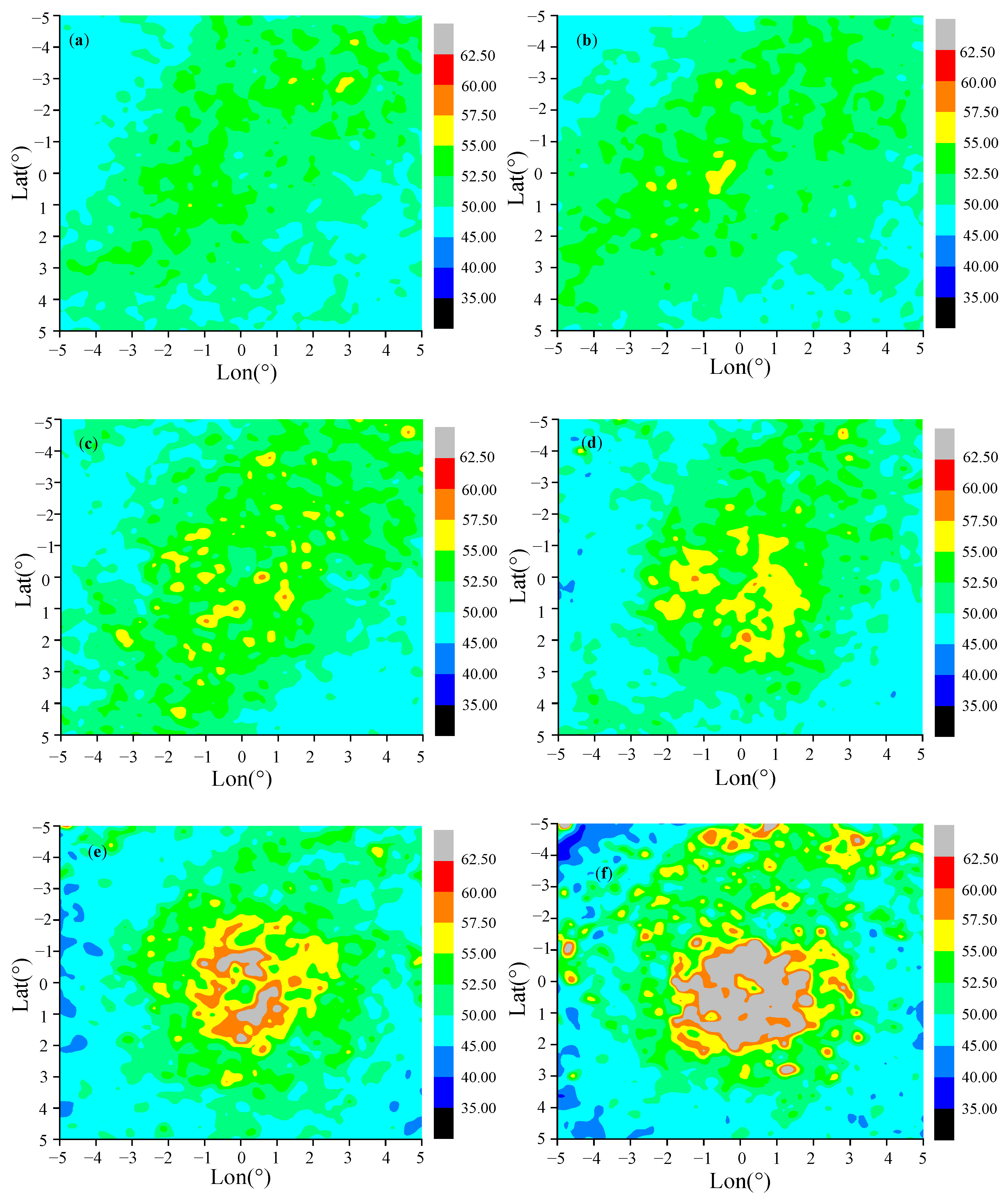
| QC | Quality Flag |
|---|---|
| 0 | Best |
| 1 | Good |
| 2 | Do not use |
| Sample Number | TD | TS | STS | TY | STY | Super TY |
|---|---|---|---|---|---|---|
| 1027 | 384 | 299 | 139 | 99 | 73 | 33 |
| TC Class | Sample Number | Correlation Coefficient | p-Value(F Test) |
|---|---|---|---|
| TD | 384 | 0.064 | 0.210 |
| TS | 299 | 0.185 | 0.001 |
| STS | 140 | 0.185 | 0.003 |
| TY | 99 | 0.469 | 8.719 × 10−7 |
| STY | 73 | 0.334 | 0.003 |
| Super TY | 33 | 0.073 | 0.6834 |
| Top of the TC Cloud System | TD | TS | STS | TY | STY | Super TY |
|---|---|---|---|---|---|---|
| Ice cloud (%) | 94.58 | 95.46 | 95.45 | 98.59 | 98.67 | 98.36 |
| Water cloud (%) | 1.81 | 1.49 | 1.71 | 0.34 | 0.31 | 0.15 |
| Ice water mixing cloud (%) | 3.61 | 3.05 | 2.84 | 1.07 | 1.02 | 1.49 |
Publisher’s Note: MDPI stays neutral with regard to jurisdictional claims in published maps and institutional affiliations. |
© 2020 by the authors. Licensee MDPI, Basel, Switzerland. This article is an open access article distributed under the terms and conditions of the Creative Commons Attribution (CC BY) license (http://creativecommons.org/licenses/by/4.0/).
Share and Cite
Liu, Q.; Wang, H.; Lu, X.; Zhao, B.; Chen, Y.; Jiang, W.; Zhou, H. Tropical Cyclone Temperature Profiles and Cloud Macro-/Micro-Physical Properties Based on AIRS Data. Atmosphere 2020, 11, 1181. https://doi.org/10.3390/atmos11111181
Liu Q, Wang H, Lu X, Zhao B, Chen Y, Jiang W, Zhou H. Tropical Cyclone Temperature Profiles and Cloud Macro-/Micro-Physical Properties Based on AIRS Data. Atmosphere. 2020; 11(11):1181. https://doi.org/10.3390/atmos11111181
Chicago/Turabian StyleLiu, Qiong, Hailin Wang, Xiaoqin Lu, Bingke Zhao, Yonghang Chen, Wenze Jiang, and Haijiang Zhou. 2020. "Tropical Cyclone Temperature Profiles and Cloud Macro-/Micro-Physical Properties Based on AIRS Data" Atmosphere 11, no. 11: 1181. https://doi.org/10.3390/atmos11111181
APA StyleLiu, Q., Wang, H., Lu, X., Zhao, B., Chen, Y., Jiang, W., & Zhou, H. (2020). Tropical Cyclone Temperature Profiles and Cloud Macro-/Micro-Physical Properties Based on AIRS Data. Atmosphere, 11(11), 1181. https://doi.org/10.3390/atmos11111181





